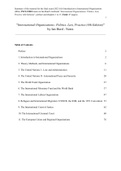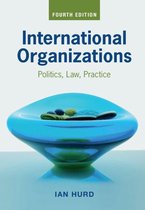Summary of the material for the final exam (2021) for Introduction to International Organisations
(IIOs). INCLUDES notes on Ian Hurd’s textbook “International Organizations: Politics, Law,
Practice (4th Edition)”, preface and chapters 1 to 11 (Total: 87 pages).
1
“International Organizations: Politics, Law, Practice (4th Edition)”
by Ian Hurd - Notes
Table of Contents
Preface 2
1. Introduction to International Organizations 2
2. Theory, Methods, and International Organizations 6
3. The United Nations I - Law and Administration 11
4. The United Nations II - International Peace and Security 20
5. The World Trade Organization 27
6. The International Monetary Fund and the World Bank 37
7. The International Labour Organization 47
8. Refugees and International Migration: UNHCR, the IOM, and the 1951 Convention 53
9. The International Court of Justice 62
10. The International Criminal Court 68
11. The European Union and Regional Organizations 76
, 2
Preface
Examines the world’s main International Organizations (IOs):
● Looks at the legal and political forces.
● Considers how these rules are used in practice (foreign policy and global governance)
International Politics = International Organizations = Legal/political features
Law and politics have a reciprocal relationship.
● IOs operate in the world's power politics.
● Governments use IOs to advance interests
IOs failures and successes come from:
1. Rules/competencies that have been set in their legal charters.
2. Interactions between these rules and other world actors.
TEXTBOOK MAIN AIM: Understand the operation of IOs in international policy-making (trade,
finance, courts, int. peace and security).
1. Introduction to International Organizations
IOs are built on a paradox:
➔ Exist in a conceptual/legal space between state sovereignty and legal obligation.
➔ They are created out of commitments made by sovereign states to each other BUT limit the
choices of those same governments.
➔ They use sovereign privileges of states to shape how those states use their sovereignty in the
future.
Three forces in world politics:
1. The commitment that states make to IOs.
2. The choices that these states make regarding compliance and non-compliance with those
commitments.
3. The power of enforcement held by each IOs
Some IOs succeed in coercing member states into complying with their commitments.
➔ e.g. UN Security Council (UNSC) has a military component.
➔ e.g. International Monetary Fund (IMF) has coercive leverage on its borrowers.
However, more commonly, IOs have to find subtler ways to induce member compliance. These
different combination choices of obligation, compliance and enforcement within an IO creates unique
political patterns between the IO itself and its member states.
The main problems of international economics and international politics are linked with problems of
IOs.
➔ As the dependence of states on each other increases, the importance of IOs also increases.
➔ Within the 21st-century, IOs are found at the heart of all political and economic challenges.
, 3
The most important IOs are:
● The United Nations (UN)
● The World Trade Organization (WTO)
● The International Monetary Fund (IMF)
● The World Bank (WB)
● The European Union (EU)
● International Organization for Migration (IOM)
● The UN High Commission for Refugees (UNHCR)
● The International Court of Justice (ICS)
● The International Criminal Court (ICC)
● The International Labor Organization (ILO)
● The Organization of American States (OAS)
● The African Union (AU)
● The Association of Southeast Asian Nations (ASAN)
Three questions that examine the law and politics of global governance:
1. What are the obligations that countries take on when they join the organization?
2. Do states in practice comply with these obligations?
3. What powers of enforcement does the organization have when members fail to comply?
When examining IOs:
1. Determine the obligations that states agree to when joining as members (legal
treaties/charters). Although it is often written clearly, there is always room for interpretation
(leeway).
2. Evaluate the competing claims by states regarding obligations (what have states agreed to do
and not do).
Most IOs are not equipped with a legal body to make authoritative judgements in compliance disputes
(excluding the EU and WTO). Thus, compliance disputes generally spill into the domain of
international law and politics.
➔ Instead, weak instruments of enforcement are used relying on discrete methods (persuasion,
reputation, status) to ensure compliance.
Obligations
Treaties that provide the foundation to each IOs set the starting point for member states, studying their
powers and effects. Once in place, the IOs’ activities are governed by the treaty’s terms (i.e. they spell
out commitments that member states take on and the powers that are then granted to the IO).
IOs are all found by inter-state treaties, which spell out the goals/powers of the IOs and
obligations/rules that govern their member states. Treaties can include:
● Direct Obligations: Rules that are explicitly set out (known in advance).
● Indirect Obligations: Open-ended rules that arise during the IOs’ course of operation. They
involve a risk that that future practice might create unexpected obligations for the Member
States.
, 4
When assessing the impact of IOs, it is important to be realistic about these obligations.
➔ E.g. The UN Charter gives the General Assembly the power to only “make recommendations”
to states (i.e. not give them binding obligations). So, its influence cannot be assessed through
compliance and non-compliance, rather in defining and contributing to state behaviour.
Compliance
A well-graded understanding of states’ legal obligations helps us consider how well they comply and
with what effects they violate them.
Compliance is viewed as a binary choice of states between “compliance” and “violation”. However,
in IOs there are two moments where state consent is explicit:
1. When they join the IOs.
2. When they see the opportunity to follow or violate its rules.
There are also moments where governments operate on international political terrain, where the IOs’
effects are structural and constitutive (ie. inescapable).
Dramatic moments where state choices are pitted directly against international rules are common in
contexts of international crises. Given sufficient incentives, states are often willing to ignore their
legal obligations.
➔ E.g. the US’ decision to invade Iraq (in 2003), despite the UN Security Council’s refusal to
grant it.
IOs ultimately shape the environment in which states exist and influence the interests/goals that states
have and the background sense of what is reasonable/normal in international politics. The subtle
effects of IOS can have a LARGE influence in the future.
Enforcement
It is rare for IOs to take effective enforcement action against non-complying member states.
HOWEVER a few have robust means (e.g. UN’s potential to authorize military action).
It is more common that state members would face a very indirect threat of punishment for their
violations (e.g. a loss of reputation).
➔ IO enforcement plays on the desire of states to be seen in a positive light, as “good
international citizens”.
The absence of direct enforcement is used as evidence of the irrelevance of IOs. However, why states
comply with IOs is hard to explain. It may be that:
● States are highly committed to the rule of law.
● States fear that other countries will be less inclined to enter deals with them if they break
international rules.
● Only cases comfortable being resolved in court are processed (explains the high compliance
data).
Sovereignty and Consent
Tensions between state obligations and state sovereignty drive world politics in and around IOs.





